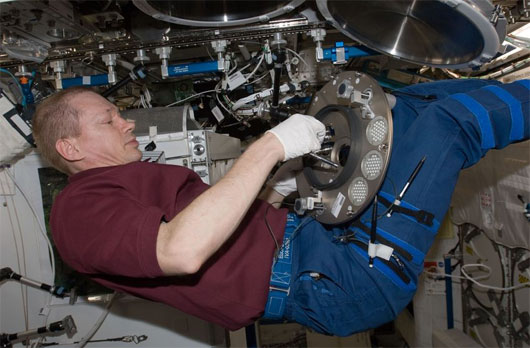Research casting alloys in zero gravity environment
In June, the International Space Station (ISS) will participate in an industrial study in which the space agency's laboratory for material science and electromagnetic lifting equipment (MSL-EML) Europe (ESA) will be taken to the station by unmanned space vehicles ATV-5 Georges Lemaitre. This is part of a research program on alloy casting ability in a zero gravity environment.
Most metals crystallize and their properties depend on micro structures. This structure will expand when cooled. An example is when you use a red hot steel knife and then dip it into cold water, unexpected cooling changes the crystal micro structure of the steel, making it harder and able to hold the sharp iron.
However, this process is in fact very complex and even more complicated when molten metal is cooled inside a mold. The difference in temperature and density, the convection force increases as molten metal is cooled and poured into the mold, and many other factors make metal casting, especially strange alloys. often considered a scientific art.

Astronaut Frank de Winne works with the MSL laboratory chamber
Gravity is one of the methods to reduce complexity, so researchers can better understand the process. In the absence of gravity, there is no convection force, so the casting of metal will need a stable temperature. Furthermore, metal samples in a zero gravity environment can be suspended in a magnetic field and heated by conductors. This means there will be no complicated elements, such as molten metal samples adhering to the mold or being contaminated by the mold.
By micro-gravity, the scientists hope to better understand the surface tension, ductility, melting temperature range, solid composition, specific heat capacity, melting temperature, mass density and elongation. thermal expansion of an alloy. These are critical factors for everything molded from a turbine rotor to a lighter alloy.
However, the problem here is that there is not much micro gravity on Earth. Of course, you can get a micro-gravity environment for 20 seconds on an airplane flying in a parabolic trajectory and more than 6 minutes on an ultrasonic velocity rocket but both are impractical to perform. a metallurgical study. So a space station like ISS has all the micro-gravity you need.
With a weight of about 360kg, the MSL-EML is built in cooperation between Airbus Defense & Space and the ESA and DLR Space Administration. The system consists of an automatic chamber that stores metal samples in a controlled and vacuum gas mixture. In addition to electromagnetic lifting equipment and thermal conductors, the system also has a digital camera, a high-speed camera with the ability to record 30,000 images per second and a thermometer.
When activated, the MSL-EML automatically loads 1 of 18 spherical metal samples ranging in size from 5 to 8 mm with aluminum, copper and nickel alloys. The whole is put into the processing chamber with a rotating relay box. The machine uses an electromagnetic field to lift the specimens in the storage chamber, keeping them from contacting the walls or other materials. After that, the thermal conductors will heat them at 2000 degrees C, bringing the material back into liquid form.

Image simulating MSL-EML system
In such a controlled environment, scientists will be able to measure many factors and study the changes of samples when they are cooled and solidified. In addition, the system does not need a crucible and specimens are not affected by gravity, which can deform the crystals or cause convection currents to prevent the metal from being cooled evenly. . Meanwhile, the sensors will record every detail of the process.
According to ESA, the micro-gravity system allows the creation of more pure test samples with fewer impact elements. Findings from the MSL-ELM can be compared to computer models and studies done with similar metal samples on Earth.
Electric lift equipment from the EML will be delivered to the ISS international space station in June by means of unmanned vehicles Georges Lemaitre along with metal samples for the first test. EML will be installed in the MSL science laboratory chamber located in the Columbus experimental module on the ISS. The system will be controlled from the Earth at the control center of the German space center (MUSC) in Cologne. After each experiment, some samples will be sent to Earth for further analysis.
ESA said the information provided by the MSL-ELM may one day be used to expand process-like processes on Earth to an industrial scale.
- Self-healing alloys increase the quality of construction work
- Telemetron - Musical instruments are designed to play in a zero gravity environment
- Gravity, gravity and things we still think
- Complete gravity measurement system nationwide
- New casting method uses polyurethane
- Interesting changes in zero gravity environment
- When the world's fastest people race in a zero gravity environment
- MIT fabricates silk guns to move in non-gravity space
- 3D printers will work on the ISS International Space Station
- The reaction of the body in a weightless environment suggests that living on Mars is still far away!
- Electric lights, solar lights ... and humanity now has gravity lights
- In a zero gravity environment, do astronauts get sick easily?
 Van Allen's belt and evidence that the Apollo 11 mission to the Moon was myth
Van Allen's belt and evidence that the Apollo 11 mission to the Moon was myth The levels of civilization in the universe (Kardashev scale)
The levels of civilization in the universe (Kardashev scale) Today Mars, the sun and the Earth are aligned
Today Mars, the sun and the Earth are aligned The Amazon owner announced a secret plan to build a space base for thousands of people
The Amazon owner announced a secret plan to build a space base for thousands of people